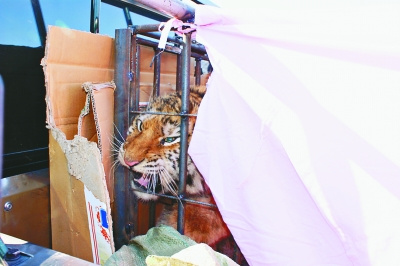Hope remains despite rare tiger cub death in NE China
Chinese wildlife experts are hoping that the finding of a rare wild Siberian tiger cub last month heralds good news for species' survival, despite the cub's death two days after its discovery.
Dong Hongyu, a senior researcher with the Wildlife Conservation Society (WCS) in northeastern Heilongjiang Province, told Xinhua after the cub died on Feb. 28 that the discovery indicated the existence of a Siberian tiger population around the Wanda mountains near China-Russia border.
 |
|
The Siberian tiger cub that was found trapped in a farmer's woodpile in NE China but later died. [Xinhua] |
Dong's speculation was shared by Zhang Minghai, head of the Wildlife Research Institute with the Northeast Forestry University.
A tiger cub could not travel far, which meant China had a wild Siberian tiger population, rather than "visitors" from neighboring Russia, as usually held by foreign commentators, Zhang said.
"The ecological environment of the Wanda Mountains has been notably restored, enabling wild Siberian tigers to breed," Zhang said.
In 22 years of field research, Zhang said he had never seen a wild Siberian tiger. "Most domestic scholars study the big cats based on their traces, such as footprints and excrement."
China's wild Siberian tigers were estimated at 20, but 1,000 tigers have been bred in captivity.
The global population of the wild species had fallen from 3,000 to 500 in the Far East of Russia, northeast China and the north of the Democratic People's Republic of Korea (DPRK).
ALL-OUT RESCUE
"We have tried our best, but she was too weak," said Qiu Hongkun, a senior tiger keeper who took care of the eight-month-old female cub found trapped early on Feb. 25 in a pile of firewood in the yard of Han Deyou, an employee with the Dongfanghong Forestry Bureau.
"She weighed 28.5 kg, only half that of a healthy cub of her age," said Sun Haiyi, deputy head with the provincial institute of wildlife.
Sun said the debility, malnutrition and stress in reaction to rescuers might have caused the death of the cub, who was believed to have been separated from her mother in the heavy snow.
A detailed report provided by the forestry bureau showed the cub ate some chicken, 300 ml of milk and two eggs from Feb. 25 to 27, with much more food left untouched.
"She struggled fiercely, even bit the cage after she awoke from the narcosis," the report said. "She had breathing difficulties and died after emergency treatment by experts failed."
"We saw her, but she was in low spirits," recalled a camera man with the provincial TV station.
Qiu and his colleagues, however, endeavoured to save the animal up to the end.
"We guarded her around the clock. Everyone was excited when she had one more bite," Qiu lamented.
The cub's body has been preserved in a special freezer, said Zhang Lei, director of the forestry bureau. "We are still awaiting instructions from the State Forestry Administration on how to appropriately dispose of it."
CONSERVATION EFFORTS
The cub was believed to be the first wild Siberian tiger found in China for at least 20 years.
Thirteen Asian countries have vowed to launch joint efforts to double the number of their wild tigers by 2022 at Asia's first ministerial-level meeting on wild tiger conservation that concluded on Jan. 29.
Improvement of wild tiger habitats could be an effective way to protect them, Zhang said.
Home to an estimated 10 to 14 wild Siberian tigers, Helongjiang, had no reserves for them, Zhang said, adding a reserve of 150,000 to 200,000 hectares could accommodate five to 10 wild Siberian tigers.
Although hunting of wild Siberian tigers has been banned in China, one Siberian tiger or Amur leopard was killed each year by snares, said a report from the WCS released in 2009.
Since 2001, WCS staff and local authorities have removed almost 10,000 snares and established 14 monitoring centers in Heilongjiang and neighboring Jilin Province, the report said.
 0
0 







Go to Forum >>0 Comments